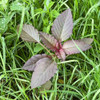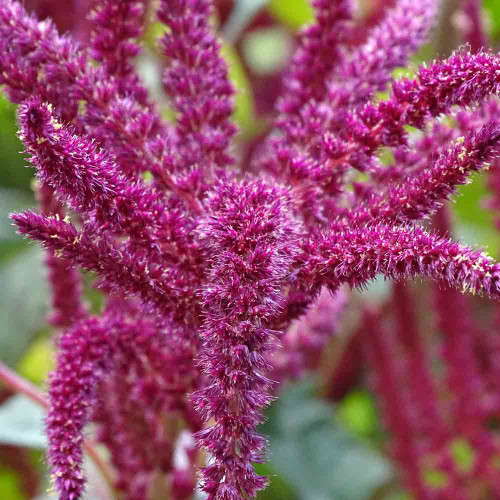Description
Hopi Red Dye Amaranth – Superfood, Showstopper, and Pollinator Magnet
Discover the multiple uses of Hopi Red Dye Amaranth, an ancient crop with a deep cultural heritage. Adorn your garden with its captivating beauty and enjoy its versatility in culinary delights, floral arrangements, and as an enticing allure for pollinators.
The vibrant red hue of its leaves and flowers will infuse your garden with eye-catching splendor, transforming it into an enchanting oasis that will be the envy of your neighbors. Its tender, nutrient-rich greens offer a delicate, earthy flavor that will tantalize your taste buds and add a pop of color to your salads, soups, and stir-fries. Discover the practical benefits of this extraordinary plant as it provides nourishment and aesthetic pleasure in equal measure.
Details
Hopi Red Dye amaranth is a tall and sturdy plant, reaching 4-6 feet tall. Its deep reddish leaves start as tiny seedlings and mature into vibrant purple-red or magenta-colored foliage, adding a splash of color to any garden. The plants withstand heat and harsh conditions, making them ideal for warm climates.
The mature plants have leaves that vary in color, with some displaying red veining or patches contrasting against the primarily green hue. The moderate leaf canopy casts dappled shade, creating a cool respite beneath the plant. The young leaves are edible, offering a mild spinach flavor perfect for salads or cooked greens.
Hopi Red Dye produces beautiful reddish-magenta flowers that cascade like waterfalls. The flowers bloom mid-summer through fall and can last for several weeks, with new buds continuously forming and opening. They attract bees and butterflies, making them an excellent choice for gardeners looking to add color and support their garden ecosystem.
Amaranth's roots go deep into the earth, bringing valuable nutrients to the surface. When the plant dies, these nutrients are released as the plant material decomposes, nourishing the soil for your next crop. The plant material and roots also contribute to the soil's organic matter content, which helps the soil retain moisture and stay healthy. Growing amaranth in your garden can improve the soil's ecosystem, yielding abundant harvests for years.
History
Amaranth is an ancient grain deeply rooted in Mesoamerica, with cultivation dating back 6,000-8,000 years.
Remarkably, diverse species of amaranth emerged from multiple centers of origin, including South America and possibly Asia or Africa. Amaranth held a central role in the Aztec civilization, rivaling the importance of maize (corn) and beans. It was woven into the fabric of their culture, serving as a sacred offering in rituals while also nourishing the people as a fundamental food staple.
Native American tribes have cultivated amaranth for centuries, likely traded through ancient trade routes. Recently, there has been a renewed interest in amaranth due to its exceptional nutritional value and historical significance, leading to its widespread use in modern cuisine.
Uses
In Hopi tradition, piki bread – a wafer-thin, crêpe-like delicacy – gets its vibrant purple-blue hue from the ash of burned amaranth seed heads, transforming the piki bread into a striking edible art. These thin, handcrafted breads have been indispensable in Hopi rituals and ceremonies.
Hopi Red Dye amaranth offers more than just fresh leaves for salads or cooking. Its vibrant flower heads can be effortlessly dried, creating long-lasting wreaths and floral arrangements that add rustic charm to your indoor or outdoor spaces. Additionally, if you have backyard chickens or other birds, amaranth seeds provide a nutritious option for supplementing their diets. This tall, slender plant is ideal for small gardens or borders and can serve as a striking vertical accent.
Companion Planting
Amaranth pairs well with sunflowers, cosmos, or marigolds to create a striking visual combination. Beans and other legumes benefit from amaranth through the beneficial insects it attracts that aid pollination and pest control.
Amaranth forms a harmonious partnership when planted alongside corn, repelling each other's pests. In addition, amaranth's pest-repellant qualities can help mitigate aphid problems on brassicas like broccoli, cauliflower, and kale. It also attracts pollinators, boosting fruit production on nightshades, such as tomatoes, peppers, and eggplant.
Amaranth’s flowers attract a variety of pollinators to your garden. Bumblebees are often seen collecting and spreading pollen from their colorful blooms, while honeybees consider it a valuable food source during the late season. Even smaller native bees can find nourishment from the flowers of the amaranth plant. Butterflies such as Monarchs and Swallowtails enjoy the nectar of the amaranth, and you may even spot the occasional Skipper or Sulphur butterfly. Although hummingbirds are not the primary pollinators, their visits to the amaranth flowers add a magical touch to your garden.
Amaranth’s height provides shade, creating a microclimate that retains soil moisture that helps neighboring vegetables keep cool and less stressed, especially during hot summer days. Additionally, its surface roots crowd out young weeds by out-competing them for soil nutrients and light.
Pest & Disease Management
Although generally quite hardy, the plant can face issues like tarnished plant bugs infesting flower heads and young growth. Regular monitoring and the use of organic insecticides may be necessary.
Overly wet conditions can lead to root or stem rots, so well-draining soil and avoiding overwatering, especially at the base of the plant, are essential. Crop rotation helps prevent the buildup of pests and diseases specific to amaranth in the soil.
Companion planting with pest-deterring plants like herbs, alliums, or marigolds can also be beneficial.
Planting Tip
Direct sow seed after the last frost or when the soil warms up; expect rapid germination in just 4-10 days under ideal conditions. Amaranth thrives in warm conditions, with optimal soil temperatures between 65°F and 75°F.
It prefers well-draining, average soil and loves full sun for the best color and growth. Amaranth can tolerate dry spells once established, making it perfect for arid climates.
Learn More
From the soil to the seed to the food you eat - we'll help you grow your best garden!

















